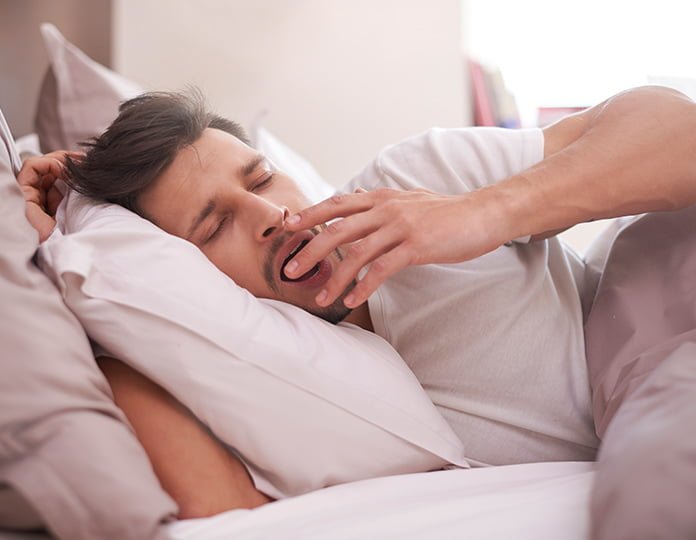It is only a fine line between being normal and being abnormal. Yet, the eminent scientists ruled some of the criteria out that clearly explain it. Snoring during sleep, though, sounds quite normal, it is a serious disorder. When it is untreated and crosses beyond the limit of more than 30 times apnoea and hypopoea per hour. This count may be between 16 to 30 times for a person with moderate OSA and 5 to 15 times for a person with mild OSA.
Well for understanding, snoring is noisy breathing and a noticeable long-term symptom of OSA (Obstructive Sleep Apnoea). Whereas OSA itself is one of the apnoea types (temporary cessation of breathing during sleep), found with multiple episodes of apnoea as well hypopoea. About 57% of the population snores during sleep among which 2% – 9% of the adult and one in every ten children found with OSA. This condition worsens with age.
What happens in OSA?
A person with OSA as discussed observed with multiple episodes of breath interruption caused due to intermittent relaxation of throat muscles resulting in blockage or restricted airflow in the nasopharynx (upper airway found behind the nose). The tissues found in the airway path flutter, and strike to and forth, creating a physical blockage resulting in a loud snoring sound. Sometimes this could cause choking during sleep. This would cause serious disruption to the partner’s sleep quality.
When is it serious?
Snoring is just a symptom. However, it is disruptive for both the person found with OSA and those who share their bedroom. The loud noise created will disturb the partner’s sleep cycle, causing disputes in a relationship. Similarly, it is injurious to also self with derogate health complications like heart attacks, car accidents, strokes, etc.

Causes and Risk Factors:
There are multiple causes for snoring like nasal congestion, small set-back jaw, tonsils, poor muscle tone in the throat and tongue, adult asthma, obesity or overweight, alcohol or drug consumption, smoking, incorrect sleeping position, sleep deprivation, soft palate or uvula, use of sedative medicines, not replacing the pillows which may contain mites, etc.,
The risk factors of OSA include diabetes, family history, high blood pressure, genetic syndromes (Down syndrome, cleft palate & cleft lip, congenital central hypoventilation syndrome, etc.), metabolic syndromes (High blood sugar, lowers the level of HDL, high level of triglycerides, increased fat around the waist, enlarged tonsils or adenoids, bruxism (night time teeth grinding), etc.,
Complications of OSA
Though it occurs only during sleep, this disorder would connect directly to a person’s complete biological cycle. Improper or interrupted breathing will lead to the following server health complication.
- Daytime Fatigue and Sleepiness: Since there is an improper supply of oxygen to the brain and other parts of the body, the lack of restorative sleep will make the person feel drowsy or irritated all through the daytime and even during work time. This might lead to poor concentration or less focussed during work or studies.
- Cardio – Vascular problem: The poor oxygen supply during sleep will increase the blood pressure of an individual. The prolonged condition will weaken the cardio-vascular muscles that may lead to serious health issues like CHD (coronary Heart Disease), heart failure, heart attack or arrhythmias (abnormal heart rhythms) that ultimately can lower the Blood Pressure. It may sometimes cause sudden death.
- Eye problem: This improper oxygen may lead to damage to eye nerves, etc.,
- Frequent waking from sleep:
- Nocturia (Night Teeth grinding).
- Bruxism (Frequent urination during night).
- Type 2 diabetes
- Acid reflux.
- Memory loss.
- Depression.
- Quarrelling in relationships.
- Mental instability and loss of focus.
How to find that I snore?
In some cases, the individual who snores will not even be aware of it. In such cases, it might be the partner who shares the bed that will bring to the notice of that individual. The level of intensity of the cases is diagnosed by the following tests.
- Imaging test: This problem is diagnosed by MRI scan, X-ray or CT scan.
- Sleep study is the method in which a person’s sleep cycle, heart rate, etc., is studied during sleep with the lab test called Polysomnography.
How to Treat?’
Only a few lifestyle modifications may help to overcome this disorder.
- Weight loss
- Quit Alcohol & Drugs
- Quit Smoking
- A body pillow to support the entire body will help to reduce the complications
- Sleep on your side avoiding sleeping on your back
- Sticking to a regular proper routine
- A hot shower before bed can help in open nasal passages
- Minor changes in sleeping position head titling high, etc.,
- Mandibular advancement Device
- Mouth exercises
- Staying hydrated always
- Tongue retaining device
- Continuous positive airway pressure therapy (CPAP)
- Medication like steroids prescribed by doctors can help this disorder
- Surgical treatments for OSA: Minor surgery in severe cases of OSA, which includes
- Laser-assisted uvulopalatoplasty
- Radio-frequency ablation.
- Septoplasty
- Tonsillectomy and adenoidectomy













Leave feedback about this